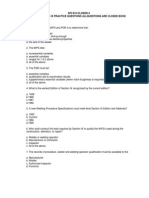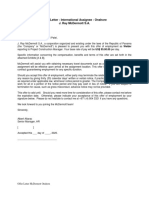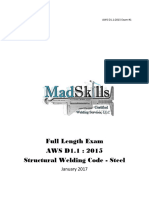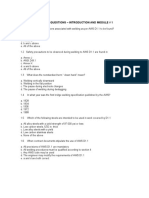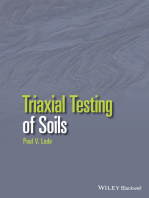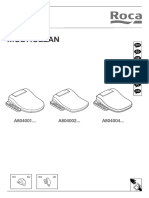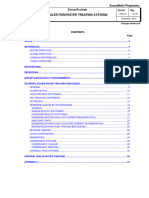26feb05 Wps PQR Open
26feb05 Wps PQR Open
Uploaded by
miteshCopyright:
Available Formats
26feb05 Wps PQR Open
26feb05 Wps PQR Open
Uploaded by
miteshOriginal Description:
Original Title
Copyright
Available Formats
Share this document
Did you find this document useful?
Is this content inappropriate?
Copyright:
Available Formats
26feb05 Wps PQR Open
26feb05 Wps PQR Open
Uploaded by
miteshCopyright:
Available Formats
WPS / PQR PRACTICE QUIZ - OPEN BOOK
(Refer to Attached PQR / WPS Documents)
Note: Encircle the letter of only one alternative which you think is most appropriate.
1. Choose correct statement from the following:
a. The PQR shows root spacing of 1/8” and same shall be followed in
production welding.
b. PQR shows beval angle 37°. It shall be followed in production welding
without change.
c. PQR does not show backing ring, hence production weld also can not
be with backing ring
d. None of above is correct statement.
2. What condition below describes the results of the guided bend test?
a. The three bend tests are acceptable and the fourth one is not
acceptable
b. The test result overall is acceptable
c. The test result is not acceptable due to the linear indication
d. The bend test result is indeterminable, carry out retest.
3. What welding process is qualified by this PQR?
a. GTAW
b. SMAW
c. GMAW
d. SAW
4. What is the P number and the tensile strength of SA-106-C?
a. P No. 1 and 70 ksi
b. P No. 1 and 60 ksi
c. P No. 3 and 70 ksi
d. P No. 3 and 60 ksi
5. In accordance with the PQR, the WPS is qualified for what welding
positions?
a. Flat and horizontal
b. Flat, vertical, overhead and horizontal
c. Vertical and overhead
d. All positions
6. What is the F No. of an E 7010 electrode?
a. F no. 4
b. F No. 3
c. F No. 2
d. F No. 1
7. The welder who welded the test plate for PQR 101 is qualified to weld in
what position?
a. Flat
b. Flat and horizontal
c. Flat and vertical
d. Flat, vertical and horizontal
8. The bend test specimen used are side bend. They are:
a. Not accepted since 2 face bend and 2 root bend must be used
b. Accepted since as alternative to (a) 4 side bend may be used
c. Accepted since only 2 bend tests are required where as 4 bend tests are
performed
d. Not accepted since all 3 types of bend tests (face, root, side) are required.
9. As far as thickness ranges for Base Metal (B.M.) and weld metal (W.M.) as
shown on WPS are concerned, your decision about the qualified range is:
a. B.M. is okay and W.M. is not okay.
b. Both B.M. and W.M. are okay.
c. Both B.M. and W.M. are not okay.
d. W.M. is okay and B.M. is not okay.
10. In production welds, if groove design is changed to double V groove for the
qualified base metal thickness, as per ASME Sec. IX will you:
a. Accept the change — since it is non-essential variable
b. Will not accept — since it is essential variable
c. Accept only if okay by radiography
d. Accept only if okay by both radiography and UT
11. Based on the specimen areas provided in PQR, are the ultimate stress
calculations correct (as rounded up to psi) for specimen T 1 and T2:
a. Calculation is okay for T1 alone.
b. Calculation is okay for T2 alone.
c. Calculations for both are okay.
d. Calculations for both are not okay.
12. Which condition below best describes the result of tensile tests reported on
the PQR?
a. Test T1 & T2 are acceptable
b. Test T1 & T2 are unacceptable
c. Test T1 is acceptable & T2 is unacceptable
d. Test T1 is unacceptable & T2 is acceptable
13. If electrode E7010 shown on WPS is changed to E7018, what is your
decision?
a. Revise WPS to show the change and re-submit as new revision
b. No revision of WPS is necessary as both belong to same F number.
c. A new PQR will be required to support the change.
d. No revision of WPS required but show the change in same PQR and
submit it as new revision
WPS / PQR PRACTICE QUIZ (OPEN BOOK)
Answer Key
Q. No. Answer Reference
1 D Table QW – 253. Options a, b, c are non-essential variables.
2 B QW – 163
3 B See PQR format 4th line from top
4 A Table QW - 422
5 D QW – 203
6 B Table QW - 432
7 A Table QW – 461.9
8 B Table QW - 451.1 and Note 3
9 D Table QW - 451.1
10 A Table QW - 253. QW 402.1
11 C General knowledge. Stress = Load / Area
12 D QW – 153 (a) and (d)
13 C Table QW - 432
---------------------------------- End -------------------------------
You might also like
- API 571 SummaryDocument17 pagesAPI 571 Summarymitesh100% (4)
- API 510 Closed Book QuestionsDocument16 pagesAPI 510 Closed Book QuestionsRavindra S. Jivani100% (1)
- ASME Sec IX - Questions For API ExamDocument21 pagesASME Sec IX - Questions For API ExamMKAMRANBHATTI87% (31)
- API 570 Final Practice ExamDocument23 pagesAPI 570 Final Practice ExamAndiappan PillaiNo ratings yet
- ASME V QuestionsDocument19 pagesASME V QuestionsabdoNo ratings yet
- ASME Section-IX QuestionsDocument18 pagesASME Section-IX QuestionsKarthik S100% (2)
- Aws Cwi Part B Practical Question rv0 PDF FreeDocument5 pagesAws Cwi Part B Practical Question rv0 PDF Freealexbv10100% (4)
- Welding Code Exam Version D1.1Document13 pagesWelding Code Exam Version D1.1Liyakathalikhan Shahjahan100% (4)
- Offer Letter McDermott Onshore - Nitin Kumar PatelDocument3 pagesOffer Letter McDermott Onshore - Nitin Kumar PatelmiteshNo ratings yet
- ToyotaDocument2 pagesToyotajerrin jaisonNo ratings yet
- Quiz 4Document3 pagesQuiz 4vamsikrishnaNo ratings yet
- PQR - WPS Review 2021Document21 pagesPQR - WPS Review 2021problematic NymphNo ratings yet
- API 510 Daily Exam 8 (OPEN) : 2. Tick Only One Alternative Which You Think Is Most AppropriateDocument5 pagesAPI 510 Daily Exam 8 (OPEN) : 2. Tick Only One Alternative Which You Think Is Most AppropriateShanawas Abdul RazakNo ratings yet
- Daily - Exam - 5B - Open and AnswerDocument5 pagesDaily - Exam - 5B - Open and AnswerGeorge KudiaborNo ratings yet
- ASME Section IX - Close BookDocument6 pagesASME Section IX - Close BooksubhaNo ratings yet
- Api 510 Open 1Document4 pagesApi 510 Open 1melvinNo ratings yet
- Api 510 Open 1Document4 pagesApi 510 Open 1ty tNo ratings yet
- API.570. Closed Book 3Document31 pagesAPI.570. Closed Book 3Siva KumarNo ratings yet
- API 653 Day 4 BookDocument59 pagesAPI 653 Day 4 BookMadhav MathaNo ratings yet
- Sample WPS 1Document13 pagesSample WPS 1waqas pirachaNo ratings yet
- Work Sheet 3Document16 pagesWork Sheet 3raghbirNo ratings yet
- Api 510 Open 5Document5 pagesApi 510 Open 5tayyabNo ratings yet
- Asme Ix QDocument20 pagesAsme Ix QAmar Natour100% (1)
- Asme Ix Practice Questions (Closed Book)Document21 pagesAsme Ix Practice Questions (Closed Book)Saptarshi MandalNo ratings yet
- Api 570Document13 pagesApi 570Jersson Ticona Zegarra67% (3)
- ASME IX PRACTICE QUESTIONS Closed BookDocument18 pagesASME IX PRACTICE QUESTIONS Closed BookNikul ViradiyaNo ratings yet
- Asme Ix Practice Questions: (Closed Book)Document38 pagesAsme Ix Practice Questions: (Closed Book)Mohammed ShakilNo ratings yet
- Sis Book Asme IxDocument107 pagesSis Book Asme IxHamza Alam100% (1)
- API 570 DAY 3 BOOK (1 To 108) (PP)Document106 pagesAPI 570 DAY 3 BOOK (1 To 108) (PP)melvinNo ratings yet
- D1.1 - 2015-Exam-1Document12 pagesD1.1 - 2015-Exam-1k8t.brown.87No ratings yet
- Exam 1Document18 pagesExam 1RamadanshishiNo ratings yet
- Api 510 PTR 7Document3 pagesApi 510 PTR 7HemaNo ratings yet
- ASME IX Multiple Choice All Questions Are Closed Book: Page 1 of 12Document12 pagesASME IX Multiple Choice All Questions Are Closed Book: Page 1 of 12Ahmed100% (2)
- API 510 Final Model Exam-Open Book Page 1 of 6Document6 pagesAPI 510 Final Model Exam-Open Book Page 1 of 6jay2kay5793No ratings yet
- API Exam Ques & AnsDocument216 pagesAPI Exam Ques & Ansdonald kakouNo ratings yet
- Api 653 Preparatory Course: Exam 5 - Closed BookDocument2 pagesApi 653 Preparatory Course: Exam 5 - Closed BookNuwan RanaweeraNo ratings yet
- Asme IxDocument10 pagesAsme IxMohammed Youssef100% (1)
- IES Electronics Telecommunication Objective Paper 2014Document47 pagesIES Electronics Telecommunication Objective Paper 2014Svv KarthikNo ratings yet
- API 510 - DAY 3: G T Technical & Management Institute PVT - LTD.Document102 pagesAPI 510 - DAY 3: G T Technical & Management Institute PVT - LTD.hamedNo ratings yet
- Exercise Questions - Introduction and Module # 1Document10 pagesExercise Questions - Introduction and Module # 1Justin Carrasco SanchezNo ratings yet
- SA 516-70 PWHT at 1100 F For 1 Hr. Satisfy UG-84 Reqmn't (Impact Test)Document4 pagesSA 516-70 PWHT at 1100 F For 1 Hr. Satisfy UG-84 Reqmn't (Impact Test)Subhan HarahapNo ratings yet
- Sis Book1Document99 pagesSis Book1Hamza AlamNo ratings yet
- 26feb05 5 ClosedDocument5 pages26feb05 5 ClosedmiteshNo ratings yet
- AWS - Visual Inspection Workshop (Exercise Questions)Document12 pagesAWS - Visual Inspection Workshop (Exercise Questions)javierNo ratings yet
- Question A to JDocument56 pagesQuestion A to JkhalleefasalemNo ratings yet
- Procedure QualificationDocument68 pagesProcedure QualificationParvee K Nakwal100% (1)
- 9) Api 510 Day 1Document109 pages9) Api 510 Day 1nivrutti2012100% (14)
- IX Exercise Rev 02 PDFDocument11 pagesIX Exercise Rev 02 PDFweerasinghekNo ratings yet
- API 510 - Day 1: G T Technical & Management Institute PVT - LTD.Document109 pagesAPI 510 - Day 1: G T Technical & Management Institute PVT - LTD.fathiNo ratings yet
- Daily - Exam - 2B - Open and AnswerDocument4 pagesDaily - Exam - 2B - Open and AnswerMahmoud AlwasifNo ratings yet
- Mechanical Characterization of Materials and Wave Dispersion: Instrumentation and Experiment InterpretationFrom EverandMechanical Characterization of Materials and Wave Dispersion: Instrumentation and Experiment InterpretationYvon ChevalierNo ratings yet
- Structural Steel Design to Eurocode 3 and AISC SpecificationsFrom EverandStructural Steel Design to Eurocode 3 and AISC SpecificationsNo ratings yet
- How to prepare Welding Procedures for Oil & Gas PipelinesFrom EverandHow to prepare Welding Procedures for Oil & Gas PipelinesRating: 5 out of 5 stars5/5 (1)
- Electrical Distribution System of a Skyscraper in the United StatesFrom EverandElectrical Distribution System of a Skyscraper in the United StatesNo ratings yet
- Electromagnetic Compatibility (EMC) Design and Test Case AnalysisFrom EverandElectromagnetic Compatibility (EMC) Design and Test Case AnalysisNo ratings yet
- Na GR 02 Sep 2016 NewDocument8 pagesNa GR 02 Sep 2016 NewmiteshNo ratings yet
- Split Type Room Air Conditioner Operation ManualDocument8 pagesSplit Type Room Air Conditioner Operation ManualmiteshNo ratings yet
- Haier Controller HBS01 ManualDocument2 pagesHaier Controller HBS01 ManualmiteshNo ratings yet
- The Process of Fatigue Analysis On Fixed Metal Offshore PlatformsDocument7 pagesThe Process of Fatigue Analysis On Fixed Metal Offshore PlatformsmiteshNo ratings yet
- SPEC CHECK Checklist-LanglaDocument7 pagesSPEC CHECK Checklist-LanglamiteshNo ratings yet
- Heat Treatment Furnaces and AtmospheresDocument12 pagesHeat Treatment Furnaces and AtmospheresmiteshNo ratings yet
- Qa-Rkm-Techdoc-Ht-A6 - PreheatDocument3 pagesQa-Rkm-Techdoc-Ht-A6 - PreheatmiteshNo ratings yet
- Support DetailsDocument1 pageSupport DetailsmiteshNo ratings yet
- Test Pack Format: Contents of Hydrostatic Test PackagesDocument2 pagesTest Pack Format: Contents of Hydrostatic Test Packagesmitesh100% (3)
- Heat Treatment and Related Processes: AnnealingDocument24 pagesHeat Treatment and Related Processes: AnnealingmiteshNo ratings yet
- Cab o SilDocument8 pagesCab o SilmiteshNo ratings yet
- QW-451 Procedure Qualification Thickness Limits and Test SpecimensDocument2 pagesQW-451 Procedure Qualification Thickness Limits and Test Specimensmitesh0% (1)
- Smart raja conceptsDocument19 pagesSmart raja conceptsivamNo ratings yet
- Climbing Ladders SafelyDocument2 pagesClimbing Ladders Safely8bgt2aepsy7No ratings yet
- Invoice 372161551 372161551 13262474Document3 pagesInvoice 372161551 372161551 13262474Gi ッLourençoNo ratings yet
- 6.2 Edde - IiDocument4 pages6.2 Edde - Iianuj_nithNo ratings yet
- Fonterra: Creaming The Profits in The Diary: Student's Name Institution Course Professor's Name DateDocument9 pagesFonterra: Creaming The Profits in The Diary: Student's Name Institution Course Professor's Name DateDoughlasNo ratings yet
- Sample Resume - FresherDocument2 pagesSample Resume - FresherAarthi shindeNo ratings yet
- ECN312 Problem Set 1Document2 pagesECN312 Problem Set 1puyaNo ratings yet
- 2023 SEDI Presentation (4425)Document26 pages2023 SEDI Presentation (4425)Huseyin KARABACAKNo ratings yet
- User Manual Multiclean Advance ES ENDocument82 pagesUser Manual Multiclean Advance ES ENJebi SeNo ratings yet
- New Insights Into The Removal of Calcium SulfateDocument10 pagesNew Insights Into The Removal of Calcium SulfatetsanshineNo ratings yet
- 25 Basel Principles of Effective Banking SupervisionDocument4 pages25 Basel Principles of Effective Banking Supervisionduc_duong_11No ratings yet
- Blandford, Colour Series Tanks Other AFVs 1900-18 (1970) OCR 9.00 PDFDocument103 pagesBlandford, Colour Series Tanks Other AFVs 1900-18 (1970) OCR 9.00 PDFBartolomeo ColleoniNo ratings yet
- VotingRecord13 Sep 2016 01 36 15 PDFDocument7,236 pagesVotingRecord13 Sep 2016 01 36 15 PDFRecordTrac - City of OaklandNo ratings yet
- Father Saturnino Urios UniversityDocument5 pagesFather Saturnino Urios UniversityNelLopezNo ratings yet
- Materials 13 00173 PDFDocument15 pagesMaterials 13 00173 PDFbelal abdelrahmanNo ratings yet
- WMD-06 Operation ManualDocument30 pagesWMD-06 Operation ManualVictor SarmientoNo ratings yet
- Letter Request For SpeakersDocument10 pagesLetter Request For SpeakersMylene Acluba LindoNo ratings yet
- Heirs of Bautista V Lindo DigestDocument1 pageHeirs of Bautista V Lindo DigestEvangeline VillajuanNo ratings yet
- Startup Program Program FlierDocument1 pageStartup Program Program FlierAdithiya BharathwajNo ratings yet
- CDR AmendmentDocument1 pageCDR AmendmentSherwin SalanayNo ratings yet
- Food CalorieDocument28 pagesFood CaloriePremaNo ratings yet
- Alliance Ascent College Bangalore - MBA - Alliance UniversityDocument11 pagesAlliance Ascent College Bangalore - MBA - Alliance UniversityRakeshKumar1987No ratings yet
- IR Preparedness Guide 1637562659Document14 pagesIR Preparedness Guide 1637562659divyanshuy8No ratings yet
- 412 33 Powerpoint-Slides Chapter-21Document19 pages412 33 Powerpoint-Slides Chapter-21Kartik KaushikNo ratings yet
- Prithviraj Nilesh ChavhanDocument5 pagesPrithviraj Nilesh Chavhansinkarmanoj2050No ratings yet
- Useful Tips For Writing ToeicDocument13 pagesUseful Tips For Writing ToeicDiệu HuyềnNo ratings yet
- Provision of Social Welfare: Challenges To GovernanceDocument42 pagesProvision of Social Welfare: Challenges To GovernanceJoan LimNo ratings yet
- Boiler Feedwater Treating Systems: Design PracticesDocument96 pagesBoiler Feedwater Treating Systems: Design PracticesAleem QureshiNo ratings yet
- Group No.7 ReportDocument16 pagesGroup No.7 ReportkervinngoleNo ratings yet

